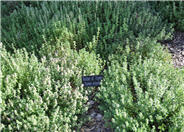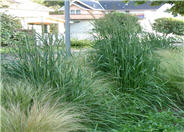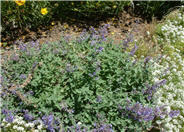
Common name:Mother-of-Thyme
Botanical name:Thymus serpyllum
Mother-of-thyme is a woody based perennial which is primarily used as a ground cover. Numerous, thin, somewhat woody stems form a low mat (2 to 3 inches tall and 12 or so inches across) with tiny, rounded, glossy blue-green leaves. Leaves are aromatic, though usually not considered to be of culinary quality. Clusters of tiny, tubular, deep pink flowers appear in summer. Flowers are attractive to bees. There are many cultivars with a more dependably low habit; the species is a bit taller and so is best used at the sides of walks of paths, or to edge a sunny border.

Common name:Feather Reed Grass
Botanical name:Calamagrostis acutiflora
Feather reed grass is perennial grass that grows 4 to 6 feet tall and 1 to 2 feet wide. It is ideal in spaces where some vertical interest would be valued. It is very upright, though the grass blades are gently arching. Flower plumes appear mid June and emerge a light green but quickly turn to pinkish purple. The flower is very airy and feathery, hence the name. Flower is looser than 'Karl Foerster.' Plumes are very persistent into the winter months. Slightly less erect than it's popular kin, 'Karl Foerster.'

Common name:Catmint
Botanical name:Nepeta racemosa
Nepeta is a fierce little perennial, growing in poor sooils and sunny, hot conditions with never a whimper. Though different nepeta vary is size and flower color, as a general rule, all are mounded and densely leaved, with heavily crinkled, aromatic, grey-green, slightly fuzzy foliage. Flowers are like all flowers in the mint family, though on nepeta the stems tend to be shorter and the flowers closer to the foliage. Usually blue to violet, blooming late spring and sometimes again in the fall. A great addition to a sunny garden or parkstrip. Many cultivars available.
| Designer: Rick Laughlin | Sunken Garden 14 |
Photographer: GardenSoft |
Water Saving Tip:
Group plants in your garden according to their water needs (hydrozone).
